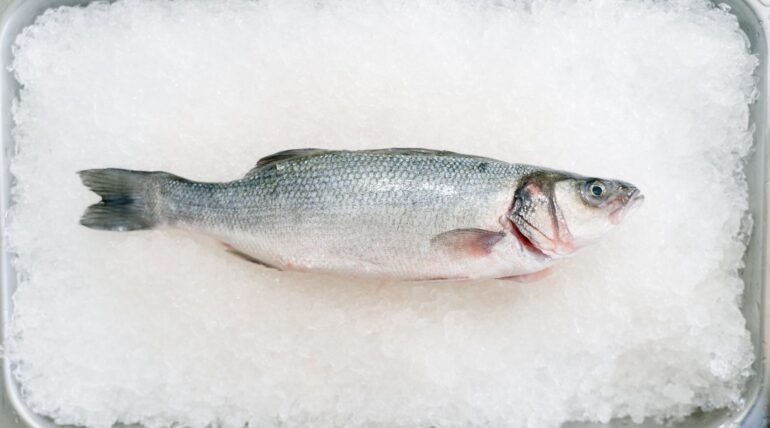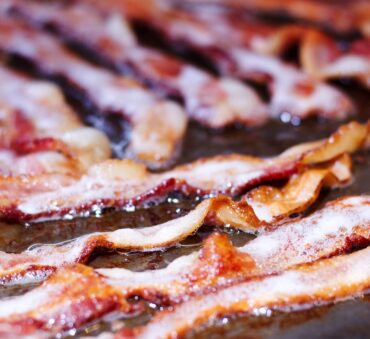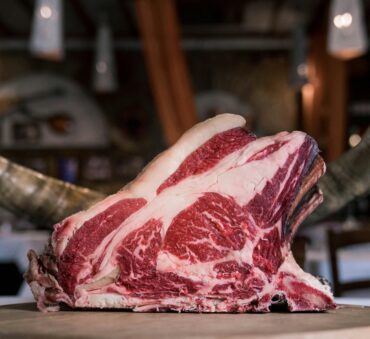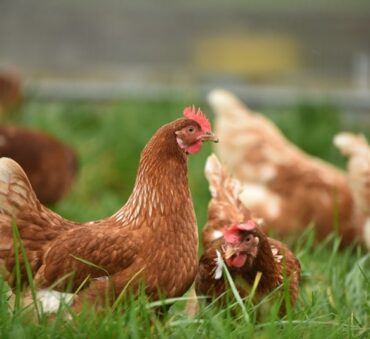The world’s appetite for seafood continues to grow, and with it comes the inevitable byproduct: fish waste.
From commercial fishing to processing facilities, fish waste is generated at various stages of the seafood supply chain. While this waste is often seen as a burden, it has the potential to be transformed into a valuable resource.
But how can you turn fish waste into other products?
Let’s explore everything about fish waste management, including some innovative methods that reduce environmental impact and unlock economic opportunities. We’ll also cover the impact of fish waste on the environment and some of the main fish disposal regulations.
Key Takeaways
- Traditional fish waste disposal methods, such as landfill disposal and land application, are common but may not maximize resource potential.
- Innovative techniques, which include converting fish waste into nutrient-rich fertilizer and high-quality feed, offer sustainable alternatives with multiple benefits.
- Waste management in aquaculture and commercial fishing is subject to regulations like the Magnuson-Stevens Act and the Marine Protection, Research, and Sanctuaries Act.
- Embracing sustainable fish waste practices not only benefits the environment but also adds value to businesses by contributing to a circular economy and resource utilization.
The Impact of Fish Waste on Aquatic Life and the Environment
Fish waste encompasses a diverse range of materials, from fish heads and bones to scales and viscera. Its composition is rich in proteins, lipids, and other organic compounds, making it a prime candidate for sustainable solutions.
But what happens if fish waste is not processed into other valuable products?
Let’s take a closer look at the different types of fish farm waste and aquaculture waste and their impact on the environment:
Solid Fish Waste
This type of fish processing waste refers to the non-liquid fish residues, including:
- Fish heads
- Bones
- Scales
- Fins
- Other inedible parts
Improper disposal of solid fish waste can clog waterways and harm aquatic life, disrupting the natural balance of ecosystems. Furthermore, the decay of solid waste consumes oxygen, leading to oxygen-depleted “dead zones” in water bodies.
Liquid Fish Waste
Liquid fish waste consists of fluids released during various stages of fish handling, including:
- Cleaning
- Gutting
- Processing
This liquid waste is high in organic matter and can pose a risk to water quality if not managed effectively. When discharged into aquatic systems, it can contribute to nutrient pollution, leading to algal blooms and detrimental effects on aquatic habitats.
Current Fish Waste Management & Disposal Practices
There are several fish waste disposal practices commonly employed within the seafood industry. These approaches aim to address the challenge of handling the substantial waste generated throughout the fish processing chain.
Let’s delve into some of the primary methods:
- Landfill disposal: One prevalent method involves the disposal of fish waste in permitted landfills that are equipped to handle such waste. This approach provides a straightforward means of waste removal but does not fully leverage the resource potential of fish waste.
- Land application: Fish industry waste can be ground and tilled into agricultural or silvicultural land, adhering to solid waste regulations. This sustainable practice contributes to soil enrichment while minimizing waste.
- Composting: This presents an eco-friendly solution for fish waste management. Through controlled decomposition, fish waste can be transformed into valuable compost suitable for various agricultural applications.
Innovative Fish Waste Recycling Techniques
Dry fish waste composition is mainly made of:
- 49–57% protein
- 21–30% ash
- 7–19% fat
This makes fish waste great material for making other valuable products.
Additionally, there are some truly groundbreaking recycling techniques that are making waves in the aquaculture industry. These are eco-friendly game-changers with the potential to transform how we view fish waste.
Here are some common fish waste uses:
Fish Waste as a Source of Nutrient-Rich Fertilizer
Fish waste is rich in nutrients like nitrogen, phosphorus, potassium, and calcium. This makes it a great supplement for enriching the soil and boosting crop yields.
So, it’s no surprise that composting for businesses, particularly those involved in aquaculture, have gained significant attention.
Here are the steps needed to convert fish waste into fertilizer:
- Pre-processing: The collected fish waste is ground or chopped to reduce it into smaller, more manageable pieces.
- Composting fish waste: This is where the pre-processed fish waste is combined with other organic materials like wood chips, sawdust, or agricultural residues. This mixture provides a balanced carbon-to-nitrogen ratio, which is essential for effective decomposition.
- Aeration: Proper aeration encourages microbial activity, which stimulates the breakdown of organic matter.
- Temperature control: Compost piles often heat up as microbial activity increases. Ideally, the temperature should reach a range of 131-160°F (55-71°C) to kill pathogens and weed seeds while promoting decomposition.
- Maturation: After several months, the compost matures, and the organic materials break down into a nutrient-rich, stable product.
- Screening: The finished organic fertilizer from fish waste may undergo screening to remove any remaining large particles or contaminants.
- Packaging and distribution: The final step involves packaging the organic fertilizer into bags or suitable containers for distribution to agricultural users. It can be sold as a commercial product or used directly on farms.
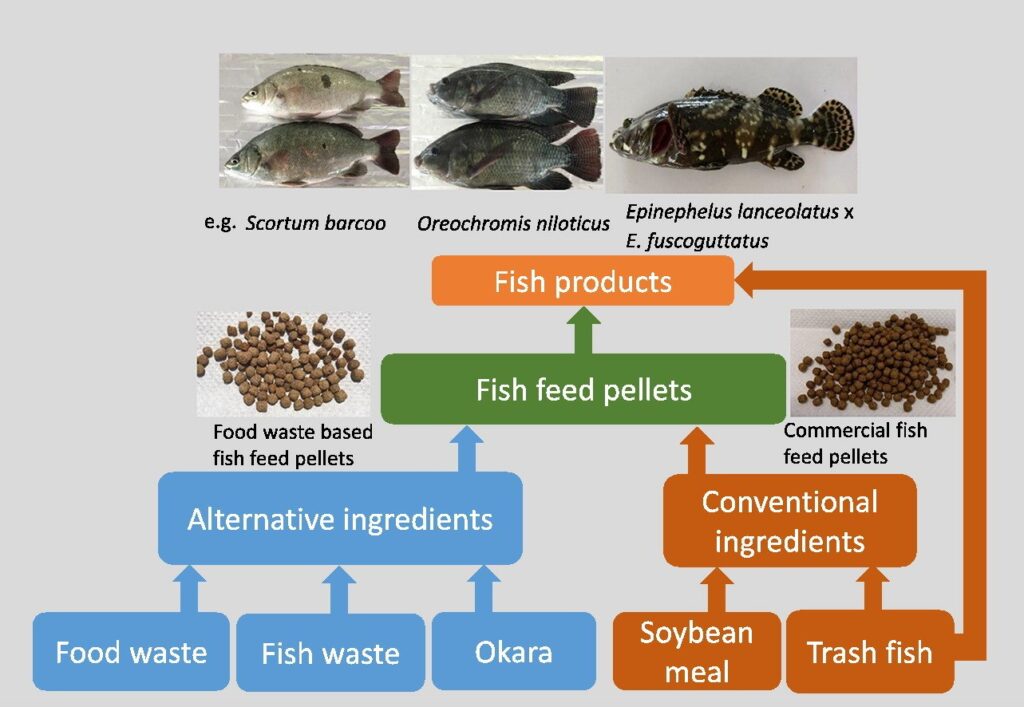
Fish Waste as High-Quality Feed
Fish waste can also be repurposed into high-quality aquaculture feed. Research in this area is thriving, with scientists exploring innovative methods to convert waste into nutritious, protein packed feed pellets.
Usually, once the fish waste is collected and minced into small pieces, it goes through the following process:
- Cooking and sterilization: The ground fish waste is subjected to heat treatment. This process not only kills any potential pathogens but also makes the waste more digestible for animals.
- Formulation: After cooking, the processed fish waste is blended with other ingredients to create a balanced feed formulation. These additional ingredients may include grains, vitamins, minerals, and binders to ensure the feed meets the nutritional requirements of the target animals.
- Pelletization: The feed mixture is transformed into pellets or granules through a pelletization process. This helps in creating uniform feed particles that are easy to handle and feed to animals.
- Quality control: This includes testing for nutrient content and contamination to ensure the safety, nutritional value, and consistency of the feed.
- Distribution: The feed is packaged and distributed to various aquaculture operations, including fish farms and aquaculture facilities.
Biodiesel from Fish Waste
Through anaerobic digestion, fish waste can be transformed into biodiesel, a renewable energy source with significant environmental benefits.
This sustainable approach not only reduces the environmental impact of fish waste disposal but also harnesses its organic richness to generate clean energy.
Here’s how fish waste can be converted into this clean energy fuel:
- Mixing: The fish waste is mixed with water to create a slurry. This helps in creating a homogenous feedstock for the anaerobic digestion process.
- Anaerobic digestion: The slurry is introduced into an anaerobic digester, which is a sealed, oxygen-free environment. In the absence of oxygen, anaerobic microorganisms break down the organic matter in the fish waste.
- Transesterification: Transesterification is a chemical reaction where the fish waste’s organic materials are converted into biodiesel and glycerol. Catalysts such as sodium or potassium hydroxide are typically used in this process.
- Separation: After transesterification, the mixture is allowed to separate. Biodiesel, being less dense, floats on top of glycerol, making it easy to extract.
- Purification: The extracted biodiesel may contain impurities and residual glycerol. Purification processes, such as washing and drying, are employed to ensure the quality of the biodiesel.
- Energy generation: Purified biodiesel can be used as a renewable energy source. It can be burned to produce heat or used in diesel engines to generate electricity. The generated energy can be utilized for various purposes, including powering facilities or supplying electricity to the grid.
Creating Value from Fish Waste: A Circular Economy Approach
Fish waste, once regarded as a problem, now holds potential as a valuable resource.
Businesses are finding innovative ways to repurpose fish waste, which enables them to reduce waste and create value-added products. This shift from a linear, wasteful model to a circular one has far-reaching benefits.
By converting fish waste into organic fertilizers, nutrient-rich aquaculture feed, and even renewable biogas, the seafood industry is minimizing its environmental footprint while contributing to sustainable practices.
The best part?
These initiatives not only reduce waste disposal costs but also offer additional revenue streams.
The circular economy approach ensures that every part of the fish serves a purpose, optimizing resource utilization and promoting a more sustainable and economically viable seafood industry.
Implementing Zero Waste Strategies in Fish Farming
In the world of fish farming, the concept of zero waste is not just a goal – it’s a necessity. To achieve sustainable and eco-conscious practices, fish farms are increasingly adopting strategies like:
- Reducing waste generation: Fish farms can achieve this by optimizing feed formulations to reduce excess nutrients that can end up as waste. Implementing efficient feeding methods and monitoring systems can also reduce unnecessary waste production.
- Recycling fish byproducts: Another key strategy is to find valuable uses for all byproducts generated in the fish farming process. These byproducts, including fish waste and processing residues, can be transformed into organic fertilizers, nutrient-rich aquaculture feeds, and even pharmaceuticals.
- Circular economy practices: By embracing a circular economy approach, fish farms are increasingly becoming hubs where waste is seen as a resource. By upcycling waste into valuable products, they not only reduce environmental impact but also create new revenue streams.
- Collaboration and innovation: Collaboration with research institutions and industry partners is vital to stay at the forefront of zero waste practices. Innovations in waste conversion technologies and sustainable packaging solutions are continuously improving waste management in fish farming.
Regulation in Fish Waste Disposal
As the world recognizes the importance of sustainable fish waste management, regulatory bodies have also stepped in to ensure responsible practices across the industry.
Here are the key regulations affecting fish waste disposal and management practices:
- Aquaculture Certification Programs: Some aquaculture certification programs, such as those by the Aquaculture Stewardship Council (ASC), have stringent waste management criteria. Fish farms seeking certification must adhere to these criteria to demonstrate their commitment to sustainable practices.
- The Magnuson–Stevens Fishery Conservation and Management Act: In the United States, this federal law governs marine fisheries management and conservation. While its primary focus is on fisheries, its provisions can indirectly influence fish waste management practices for commercial fishing operations.
- Marine Protection, Research, and Sanctuaries Act (MPRSA): This U.S. federal law, also known as the Ocean Dumping Act, addresses marine pollution and waste disposal at sea. Under MPRSA, the dumping of fish waste at sea is regulated to protect marine environments and ecosystems.
- Wastewater Discharge Standards: Fish farms are typically subject to wastewater discharge standards that specify acceptable levels of pollutants in effluents. Compliance with these standards ensures that discharged water does not harm aquatic life or ecosystems.
- Fish Meal and Oil Processing Regulations: Facilities involved in fish meal and oil production are often subject to specific regulations. These may include requirements for waste storage, treatment, and disposal to prevent environmental contamination.
Conclusion: Transforming Fish Waste into Sustainable Resources
The fish waste management industry holds an array of innovative solutions that turn what was once considered waste into valuable resources. From organic fertilizers to nutrient-rich aquaculture feeds, the potential is limitless.
At Shapiro, we stand as your trusted partner in embracing these sustainable practices. Our expertise in waste management extends to the realm of fish waste. We offer tailored customized solutions for recycling food waste to maximize resource utilization while minimizing environmental impact.
Call us today to learn how we can help you turn your waste into a valuable resource.
Baily Ramsey, an accomplished marketing specialist, brings a unique blend of anthropological insight and marketing finesse to the digital landscape. Specializing in educational content creation, she creates content for various industries, with a particular interest in environmental initiatives.
